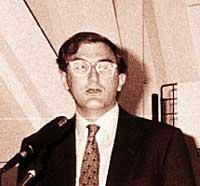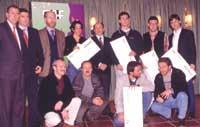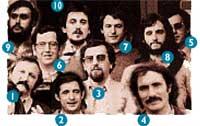Twenty-one years and 100 copies
1995/10/01 Irazabalbeitia, Inaki - kimikaria eta zientzia-dibulgatzaileaElhuyar Fundazioa Iturria: Elhuyar aldizkaria
That scientific journal as simple and noisy as Elhuyar (forgive me Luis, Andoni and others, but I took the form when I met her) came to work new fields in Basque culture: science and technology. Apart from the books by Gabirel Jauregi, Pisia and Kimia of pre-war, there was hardly any science in Basque. In the first issue of 40 pages published in September 1974, the editorial clearly expressed the intentions of the new publication that came to the square of Basque culture:
“In order for the Basque language to come to the place of science, we must pressure those present to show us what it is and among all we can help them create an increasingly mature, more appropriate, more decorated world.”
These lines indicated the objective well: “b for creators to show us how it is.” At the time of making the magazine, the reader was not primarily regarded, as should be done in such a magazine, but rather the writer. The goal was to train writers and language and that was swimming in the product. “Hik writes chemistry in Basque, it doesn’t matter what” I was told when I approached the members of Elhuyar, and so I was firing the heavy works of chemistry that nobody could swallow.
What from the present point of view may seem like wrong behavior, was not then a wrong philosophy, but was necessary. I trained in writing and formed in writing. A great Andalusian poet wrote that the road is made walking and in our case there was no lack of reason. Thus, for example, Luis Bandres departed from the paths of physics in that first issue and they went “ripping” of grain, accumulating material so that the professors of the ikastolas explained in Basque the concepts of physics. Same in other scientific fields. You could not wait.
In the coming years the magazine continued with the same idea: to search for new writers and form the language. There were exceptions. No. 17 (1978) P. M. Etxenike and R. H. The article entitled “The Wake Potential of Fast Ions in Solid State”, published by Ritchie, aimed to demonstrate that high-level scientific research could also be disseminated in Basque. It was a demand and a symbol, but Adolfo Suárez’s words remained fresh (“You can’t explain nuclear physics in Catalan or Basque” a little further down). The exception then is common today.
In 1981 the magazine had its first profound renewal. Who needed the number 26 was called 7, 1 on the path of standardized scientific journals. Ours was not, however, normalized. In the editorial of this issue it was said, among other things:
“Because the challenge we face today is very different and the need to respond to a different situation with different barriers is evident. We do not have to convince anyone, at least the Euskaldunes, that scientific subjects can also be written in Basque, so the role of today is to demonstrate that interesting things can also be said in Basque and also demonstrate that we are able to express ourselves in a pleasant way... People will not buy magazines in Basque because they are written in Basque, but because what is said in them is interesting.”
That was the challenge, to say interesting things in a pleasant way. The effort was great. The model was modified, the journal was divided into sections and scientific and technical dissemination was given more weight. In any case, the image was still a magazine of the paw.
However, Elhuyar was not a standardized scientific journal and that worm ate viscera. It didn't look standard, the book format didn't benefit. The content was also a sort of basket, starting with school material and ending with research articles. Basque culture deserved something else and we were also in a situation of improvement.
In 1985 we made the decision to make a standard scientific journal. We decided to divide it into two parts: disclosure and research. In December 1985 Elhuyar. Zientzia eta Teknika's zero number was published and, despite being a pastiche of previously published articles and being a zarpela very compared to the current ones, it had a great success at the Durango fair. He taught us that we invented the way. In a few months we double the number of subscribers.
Throughout the tour we have managed to configure the magazine that you have in your hands and that is much closer to the starch. The magazine, initially bimonthly, has completed 100 copies, with significant differences between the number zero and the number one hundred, both in the model and in the contents. There is no denying that we have improved, but we still have a lot to improve.
We are offering the reader a journal of dignified scientific and technical disclosure. However, it still lacks some standard. Most of the challenge is to improve the style of articles and the communicative capacity, as well as the training of professionals who do so. Unfortunately, I don't think everything is in our hands, we need outside help.
Elhuyar and Elhuyar are making a great effort. The effort and publication of scientific and technical journals has skyrocketed. Our forces are not enough. If standardization is to be advanced, the economic aid of the Basque administrations is fundamental.
Who will grab the bull from the branches?
Computer science versus self-trainingUntil 1984, typewriters were the technology used in the production of books. That year there was a strategic change in Elhuyar when we acquired a Rank Xerox computer to process texts. The advantage with respect to typewriters was enormous and thus, to write mathematical formulas or make corrections it was not necessary to make an effort of yesteryear. However, we didn't have a printer because it was very expensive. Therefore, we continue to look for something else and move to the office, along with the laser printer, Macintosha, recently launched in 1986. This technology, besides giving stability, opened the doors to new paths. Initially it was considered a system to make the books in order, but at present we have the database of subscribers of the journal or encyclopedic dictionary entries in Macintosh. At the end of the last decade we began to develop learning software on the IBM Pc platform and have developed different products that help to learn mathematics, physics, geography or Basque. In recent years we have taken another step and that has been introducing us to the multimedia world. For this we have based on the experience of having worked on platforms Macintosh and IBM Pc and we already have our first product, the CD-ROM “ Ezagutu Gipuzkoa” in the street. However, the success of the computerization process has been based on the innovation capacity of Elhuyar members. A. Sagarna and J. Knife |
A new step towards disclosure
Although it has been said on more than one occasion, being something to be made clear, you will forgive the reader to repeat himself again. The first steps of the Elhuyar Cultural Association were to demonstrate that our language, not yet adapted to “science” and “technique”, was not a secondary language. That is, to demonstrate that ours is, like the rest, a language that can be suitable for dealing with any subject. Therefore and with this objective, the disclosure was left in the background, offering writers the opportunity to form and demonstrating to those who thought they were wrong.
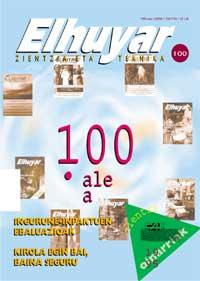
With the passage of time it was not enough to do so, so the second step was to give its space to disclosure and take care of the quality of the content. During that time we tried to balance both parts, although we did not manage to maintain that balance in all specimens. Logically, since the new path was the development of disclosure, this was the one that in most cases was very pathetic and the articles we published were too compact. In this second phase, the aim was to provide the reader with a self-training material suitable for its content. And to fulfill this objective we had prepared our infrastructure, in which those dedicated to the dissemination were mainly teachers or technicians and our forces focused on publishing in appropriate Basque.
So things and as we approach the new challenges, it's time to take another step. That is, maintaining what we achieved until then (and improving it if possible, strengthening the network of collaborators, for example), the time to give a good agitation to the appearance and make a special effort to adapt to a time when the image and the image are the main. Think and do (at our low level, of course), since this type of changes has two parts, the new design (as we had already done by hand) and the care of the graphic part of each. Although we try to apply the latter in all numbers, we don't always publish the product we wanted, for many problems (including money).
But this new era had another gap and has to do with its content. It is not enough to publish it in appropriate Basque and with a good look, it is essential that the content is also streamlined and made in a way that is easy for anyone. To do this it was essential to bring a journalist to the team, something that has become a reality today.
Therefore, and finally, tell you that we are taking new steps towards non-stop disclosure and thank all the people who contribute something to bring to light the new copy of the period, start by the writers and finish with you as a reader, because without a reader it is not possible to endure.
R. Director of Arrojeria Magazine
Cooperation
When Elhuyar magazine issue 0 was published, Zientzia eta Teknika was studying Basque at the barnetegi in Kortezubi. I went to the Durango Fair and there I discovered what that magazine was and what the Elhuyar group was. It was from Elhuyar the math books I read to work on the mathematics dictionary, the UZEI dictionaries and the UEU scientific literacy books.
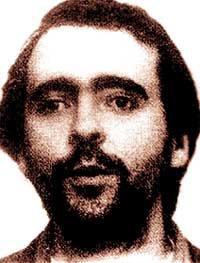
For the first time I received mathematics classes at the UEU in 1986 in Basque and the members of Elhuyar explained scientific literacy to me. At the end of the year Elhuyar gave me the opportunity to write my first mathematical book, which was published the following year. Meanwhile, in the journal on mathematics J. M. Goñi and J. They were in charge of Duoandikoetxea. At the end of 1987 Elhuyar offered me a fixed section collaboration and since 1988 I have written without interruption on the subject of mathematics, first in the section of Mathematical Games, then in that of Curious Mathematics and finally in that of Mathematics.
The first six copies of the year became eleven, forcing us to shake our heads. It wasn't always easy to guess what to write in the next issue. But the truth is that I liked work and in my mind they seemed to me ideas.
Beyond history, I want to bring my reflection here. The initial emotion generated by writing in a journal can reach the goal. If my goal was to expand mathematics, I could not settle for writing. These and other questions come to mind: Are my articles interesting? How many read? And the quality? And the level? Perhaps the same questions as most writers are the loneliness of writers? However, I don't know what answer.
I don't know for readers. According to the results of the survey conducted by Elhuyar, 18% read mathematical topics. I would like to take this opportunity to encourage the reader to contribute ideas, articles, opinions and help. This section, on Mathematics, is not closed, not mine or Elhuyar, but open and everyone.
Thank you and congratulations to Elhuyar!

Gai honi buruzko eduki gehiago
Elhuyarrek garatutako teknologia



